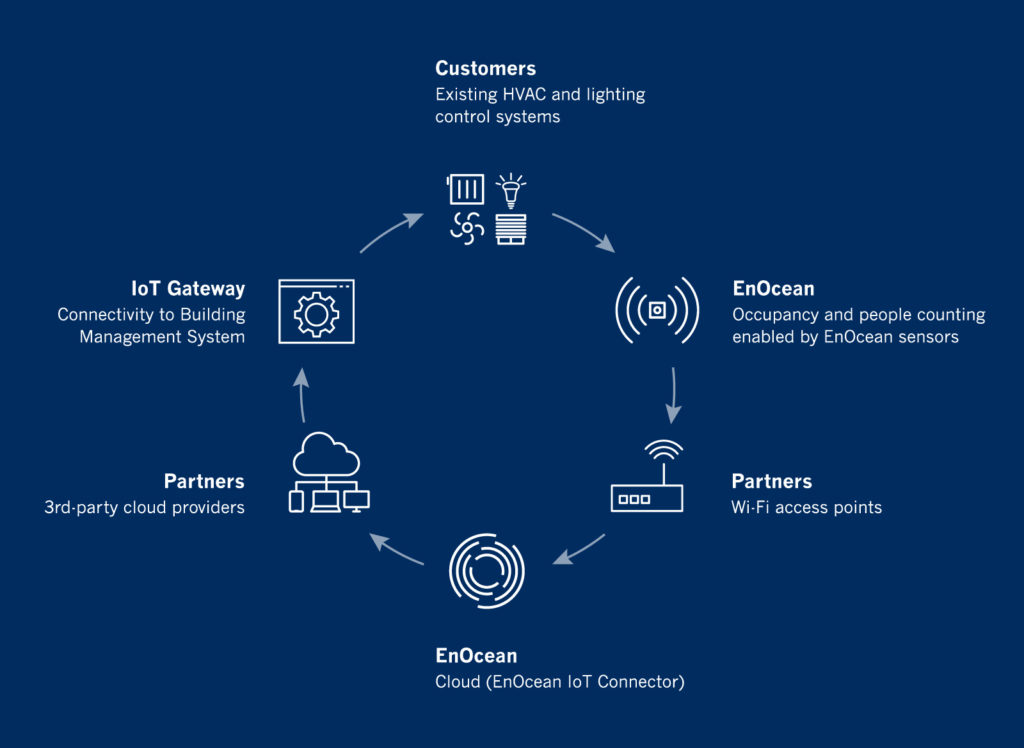IoT Revolution in Smart Buildings: Driving Sustainability and Efficiency
The Internet of Things (IoT) is rapidly evolving, revolutionizing our living and working environments. It offers businesses unprecedented opportunities to enhance efficiency, productivity, and environmental responsibility. With buildings contributing significantly to global CO2 emissions, IoT technology emerges as a key solution for reducing their carbon footprint and improving sustainability in smart buildings.
Cost savings and reduced environmental impact with IoT and wireless sensor technology
At the forefront of sustainable IoT solutions are wireless, battery-free sensors. These innovative devices can be effortlessly installed using a “Peel & Stick” approach, monitoring real-time data on various parameters. This valuable information is then utilized to optimize building systems, including lighting, HVAC, and security, resulting in reduced energy consumption and improved comfort.
How building tenants can benefit from sustainable IoT solutions
IoT solutions empower building tenants and facility managers to transform their spaces into more sustainable environments. By deploying IoT sensors throughout the building, real-time data on temperature, humidity, air quality, ventilation, energy usage, and occupancy is collected. This wealth of information enables informed decision-making to optimize building performance, such as adjusting temperature and lighting settings, identifying and addressing maintenance issues promptly, and improving overall energy efficiency.
The power of IoT extends to recognizing long-term patterns and trends, allowing building managers to make strategic decisions about maintenance and upgrades. Additionally, sensor-based solutions provide remote access to building controls, enabling monitoring and adjustments from anywhere, reducing response times and costly on-site visits. Consequently, facility managers can now optimize building operations, reduce costs, and enhance the comfort and productivity of occupants and employees.
Wireless sensors for a more productive and sustainable work environment
Wireless sensors play a crucial role in creating smarter, more sustainable buildings. For example, they detect room occupancy and adjust lighting accordingly, reducing energy consumption while creating a more pleasant and productive work environment. Similarly, sensors in HVAC systems monitor temperature and humidity, adjusting settings based on occupancy. This approach not only reduces energy waste but also improves air quality, contributing to both sustainability goals and occupant comfort.
Another strong application of sustainable IoT solutions with a high ROI is in new work models like desk sharing. Using wireless sensors to monitor desk occupancy, companies are ensuring efficient use of office space, reducing the need for additional offices. Moreover, sustainable IoT solutions allow for more informed decisions about building utilization and enhance security by using sensors to monitor and control building access, ensuring only authorized personnel have access.

Smart servers as the core of IoT-controlled building management
In smart buildings, the sensors operate as eyes and ears, while the cloud is the brain and the smart servers act as hands that carry out the desired changes. Smart servers are revolutionizing building management by enabling more efficient and effective control of HVAC and lighting systems. These servers seamlessly integrate with existing infrastructure, offering smooth integration into buildings without extensive and costly retrofits.
Specialized smart servers for IoT applications provide exceptional benefits to building tenants looking to optimize their facilities. This system goes beyond simple reports and dashboard features. It actively manages buildings to optimize energy consumption and overall performance. Building managers can automate lighting and HVAC control in line with sensor data, achieving significant energy savings and improving occupant and employee comfort.
Easy and seamless implementation
Even better, sensors and smart servers are seamlessly integrating into existing Wi-Fi networks, eliminating the need for additional gateways or IT infrastructure. This makes installation significantly smoother and more cost-effective, as there’s no requirement for new hardware installation or additional cables. Instead, the system utilizes existing Wi-Fi access points for connectivity and communication with building lighting and HVAC systems. This way, existing buildings are transformed into smarter, more sustainable facilities without the disruption of daily operations, major renovations, or expensive infrastructure upgrades.
Energy harvesting: sustainable energy supply for IoT sensors
Battery-free sensors powered by energy harvesting are a sustainable and cost-effective solution for IoT in smart buildings. They generate power by extracting energy from the environment, such as light, temperature, or motion. Energy harvesting offers several advantages over conventional battery-powered and wired sensors. First, it eliminates the need for expensive and environmentally damaging batteries, reducing overall costs and the environmental footprint of the sensors. In an enterprise environment, the total cost for a battery change is about 25 Euro per battery, required every 1-2 years.
Second, these sensors are more flexible and adaptable. They can be placed in locations where it would be difficult or impossible to lay power cables or replace batteries. This flexibility is a crucial factor, especially for retrofit projects. Finally, the sensors operate indefinitely, reducing the need for maintenance and replacement over time. EnOcean has customers that installed the system over 20 years ago, and it has been doing its job maintenance-free ever since.
Conclusion: IoT as the key to sustainability in smart buildings
Sustainable IoT solutions are a win-win for businesses and the environment. By implementing solutions that utilize wireless and battery-free sensors, building tenants are lowering their energy consumption and costs sustainably while enhancing the working environment for their employees. Simultaneously, they are contributing to a more sustainable future by reducing the carbon footprint of their facilities. With new work models like desk sharing on the rise, the time to embrace sustainable IoT practices in smart buildings is now.
